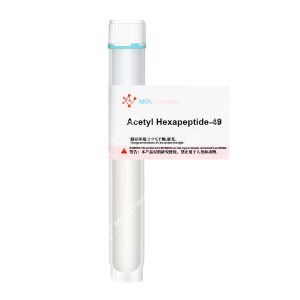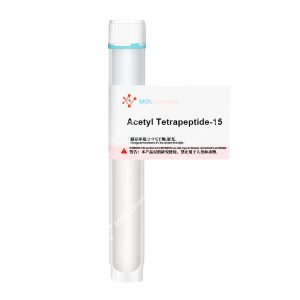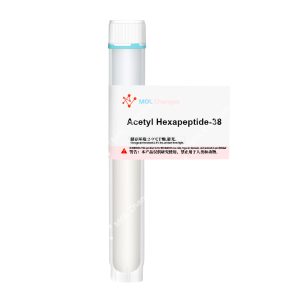Acetyl Tetrapeptide-2 is a bioactive peptide that has received considerable attention within the high-end cosmetics sector in recent years.
Mimicking the activity of Thymopoietin-4, it targets specific structural proteins found in the dermis.
Proper assembly of functional elastic fibers and the subsequent stimulation of Type I collagen synthesis are two of its primary modes of action.
Enhancing the internal structural integrity and various mechanical properties of the skin is the end result of these actions; signs of both aging and gravity-induced aging are effectively counteracted.
Sequence
Ac-Lys-Asp-Val-Tyr
CAS Number
757942-88-4
Molecular Formula
C26H39N5O9
Molecular Weight
565.62 g/mol
Research Of Acetyl Tetrapeptide-2
1.Mechanism of Action: Signal Transduction and Core Function
As a signaling peptide, Acetyl Tetrapeptide-2 is engineered to mimic (to a large extent) endogenous human peptides.
Specific ‘instructions’ are delivered to skin cells; structural degradation associated with the aging process is what it seeks to reverse.
The core function mentioned above – structural integrity and enhanced mechanical support for the dermis – is its defined purpose.
Referred to colloquially as the “Gravity Peptide”, resisting sagging is consistently highlighted as one of its more important uses.
2.Reworking the Skin Extracellular Matrix
Significant stimulation of fibroblast synthesis is what Acetyl Tetrapeptide-2 achieves.
Type I collagen being the primary structural protein, plumpness and all related strength properties are improved.
One study quantified the effect – up to 47.3% increased synthesis was observed.
Upregulation of at least some collagen related gene expressions is believed to be part of its mechanism.
Increasing the absolute quantity of (near permanently) available collagen is the true end goal; wrinkles and all associated poor texture, are reduced.
3.Promoting Elastin Synthesis and Functional Assembly
Research confirms that Acetyl Tetrapeptide-2 significantly promotes elastin production, with increases reaching up to 21.7%.
More critically, it upregulates the gene expression and subsequent protein levels of two proteins essential for functional elastic fiber assembly – FBLN5 (Fibulin-5) and LOXL1(Lysyl oxidase homolog 1).
FBLN5 serves as a “molecular scaffold,” guiding newly synthesized tropoelastin onto microfibrils for correct deposition.
LOXL1, the catalytic enzyme, catalyzes the necessary cross-linking between elastin monomers; forming a stable elastic fiber network.
Synergistic regulation of these two key factors is what Acetyl Tetrapeptide-2 achieves – increasing both quantity and functional assembly of elastin.
Countering gravity directly, improvements in skin sagging and laxity are observable effects of this process.
4.Effects on Keratinocyte Mechanical Properties
HaCaT cells are an immortalized human keratinocyte cell line commonly used in skin biology research.
Treatment with the peptide alters the elasticity of these cells.
Extending its activity beyond simple dermal fibroblasts, influencing the mechanical properties of at least part of the epidermis is a plausible and important line of research – overall skin resilience would benefit from such changes.
5.Applications and Efficacy
With well defined anti-aging mechanisms and multiple lines of both in vitro and human based efficacy studies, Acetyl Tetrapeptide-2 has truly emerged as a star ingredient in modern premium skincare.
Firming and lifting are its primary, near universal applications; creams, serums, neck products and any ‘defy gravity’ type formulation will always have this at their core.
Collagen (and to a point elastin) synthesis is also improved, all leading to a more restorative, smooth, and structurally soundly aged skin.
Preventive anti-aging is a very real end point of all of this.
COA
HPLC
MS









Reviews
There are no reviews yet.